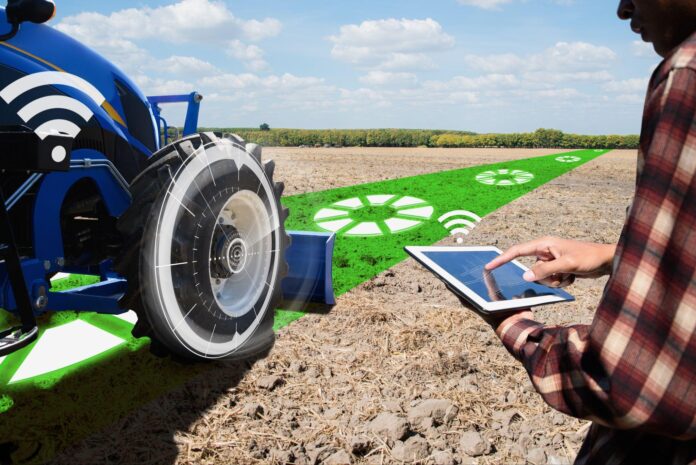Introduction
With the growing population, the need for agricultural land for food is becoming a challenge. There is a high demand for food supplies, as all living beings depend on plants for their survival. Thus, it is estimated that by 2050, the demand for agricultural production will increase by 70% for about 9/10 billion people.
However, climate change is affecting agricultural production. It is and will become an obstacle to meeting the growing population’s demand for food supply. Thus, precision agriculture is one hope for farmers to optimize productivity and help meet the growing demand for food.
In this article, we will see what precision agriculture is and how it could help meet the high demand for food without destroying additional natural resources.
What is Precision Agriculture?
Precision agriculture is the concept of farming management based on calculations and observations. Numerous technologies, like drones, sensors, GPS, etc., are utilized for precision agriculture. They are essential to reducing costs, improving profitability maintaining, etc.
Through advancements in technology, precision agriculture and the use of technology would be much more enhanced. They utilize information technology to accomplish their purpose. They also contribute to the safety and sustainability of the environment. It also ensures optimum increments in productivity. They use several autonomous and IT technologies to study various aspects such as terrain, soil, plant growth, weather, etc.
Benefits of Precision Agriculture
The benefits of precision agriculture are as follows:
1) They help to minimize the cost by reducing the utilization of herbicides, fertilizers, etc
2) They contribute to increasing profitability by applying agronomic concepts at large resolutions.
3) It helps to provide sustainability by minimizing carbon emissions.
5) It contributes to understanding the yield season.
Why is precision agriculture important?
“Precision agriculture is like understanding what your plant needs and providing it exactly what and when it needs it in exact timing.”
Farmers can control all the required steps remotely with this precision agriculture system. Even a single farmer can manage a huge field or group of land. Because of this, the concept of precision agriculture is increasing. Let’s see some other reasons why precision agriculture is important in today’s ecosystem:
Addressing Climate Change
In today’s ecosystem, climate change is hugely impacting agriculture. So, how can farmers adapt to the changing climate?
The answer is simple: precision agriculture. Precision agriculture, which includes techniques like minimizing greenhouse gas emissions from fertilizers, can help tackle climate change.
Besides, precision agriculture helps farmers adapt to changing weather and extreme events.
Conserving Natural Resources
Agriculture is the major cause of deforestation, habitable loss, and water pollution. This natural problem can be reduced using precision agriculture. So how can this agricultural method achieve it?
Precision agriculture helps reduce the use of pesticides, overuse of water, and fertilizers. This ultimately helps to reduce pollution and conserve natural resources. Thus, precision agriculture optimizes resource use while preserving biodiversity and ecosystem services.
Promoting Sustainable Development
Precision agriculture helps solve big problems like hunger, climate change, and responsible farming by using resources better, protecting the environment, and making sure farmers have enough food and income.
Increase Efficiency
It requires years of experience to understand your plant’s requirements if you want to start with traditional agricultural methods. Precision agriculture can target inputs like fertilizers, pesticides, and water when required. This increases the efficiency of the plant, resulting in the production of more food with fewer resources, reducing waste.
Technologies Used in Precision Agriculture
Numerous technologies are used in precision agriculture, including:
Ground positioning system (GPS)
It helps in precision agriculture by mapping fields, irrigation systems, and soil testing in particular areas. They also help in detecting problems with plants. They are employed to drive tractors via the parallel steering system.
Cellular Devices
The growth of mobile phones has allowed farmers to have access to data anytime and anywhere.
Robotic System
Robotic systems contribute to precision agriculture by helping to plant greenhouse crops, destroy weeds, and more.
Internet of Things (IoT)
It helps to operate field sensors. They also contribute to satellite viewing for proper monitoring of the field.
Proper irritation
Traditional irrigation leads to the wastage of water, as a large percentage of water is spilled outside. Proper irrigation provides water to roots, specifically by minimizing the spilling of water.
Variable Rate Seeding (VRA)
It helps to distribute seeds appropriately for the optimization of yields. They help to manage the germination of seeds along with the development of crops to manage risks.
Sensors
Sensors are employed in Precision agriculture to collect various data such as the fertility of the soil, the temperature of plants, the status of water in plants, etc.
Weather Modelling
Weather modeling can be employed to measure data concerning weather appropriately. They can help provide details regarding the harvesting of certain products at particular temperatures.
Emission reducing technologies
Precision agriculture can help mitigate emissions by assisting farmers in utilizing fertilizers and other inputs in an efficient and precise manner.
GPS-guided Tractors
GPS-guided tractors allow the utilization of GPS signals for automated farming tasks. GPS technology within the tractors operates by utilizing signals from the satellite to deliver data on location. Additionally, the GPS used by the tractors can process that data. The data can be displayed on the tractor screen. This can help the farmer operate as well as navigate their tools with accuracy. GPS guidance on tractors can help automate numerous tasks, like tool regulation. They can also track progress and automate steering.
There are numerous advantages of using GPS guidance on tractors, such as:
1) It can be helpful to reduce the cost of manpower.
2) They can contribute to enhanced crop yields.
3) It can be essential to improving efficiency.
4) It can also contribute to precise operations in less visible situations as well.
Variable Rate Irrigation Systems
Precision in the irrigation system’s water delivery is essential. The profitability and sustainability of land depend upon various factors such as delivery speed, application depth, flow rate, etc. Hence, VRI technology, or variable rate irrigation technology, can be very helpful to accomplish this.
VRI can help deliver variable irrigation levels. This can contribute to ensuring accurate water delivery to the crops in their lifecycle. This is also helpful for applying proper water amounts as well as chemicals to the accurate places at the perfect time.
VRI systems accurately pinpoint where there is a requirement for water. Further, a prescription VRI can be generated to ensure the pivot system provides an accurate amount of water in the needed areas. Similarly, VRI can also regulate every sprinkler in an effective way by turning them on/off individually. They can also help understand soil irrigation features to avoid tracks and lands that are unproductive.
VRI systems have numerous benefits, such as:
1) It helps to reduce costs as the water consumption is precisely managed.
2) They can help reduce the loss of nutrients in soil via leaching and enhance the health of soil.
Besides, VRI systems can contribute to reducing the utilization of water in two different ways.
1) The non-cropped area from the application of water can be excluded.
2) Water application rates can be minimized in soils that have a large capacity for holding water.
New Technologies for Precision Agriculture
Some of the new technologies that would be used in precision agriculture are as follows:-
1) Drones/UAVs
In general, Drones/UAVs are utilized for military and research purposes. However, in modern times, their implementation has seen huge growth in numerous sectors, including agriculture. Farmers can use them to track their fields and optimize production.
2) Automated guidance systems
Automated guidance systems can guide farmers to navigate their vehicles in any sector with optimum accuracy.
3) Grid sampling
Grid sampling can be an essential method for field segmenting into the size of half to five tors-sized units.
Conclusion
Precision agriculture is utilizing digital and AI power for enhanced farming management. The integration of industry-based technologies, like drones, robotics, etc., has improved farming. These technologies are contributing to the shaping of the future. They help make an informed decision-making process for the practice of farming.
In other words, precision agriculture is the present and the future, with more use of UAVs/drones and smart technologies. These technologies can make the world a better place for agriculture.





